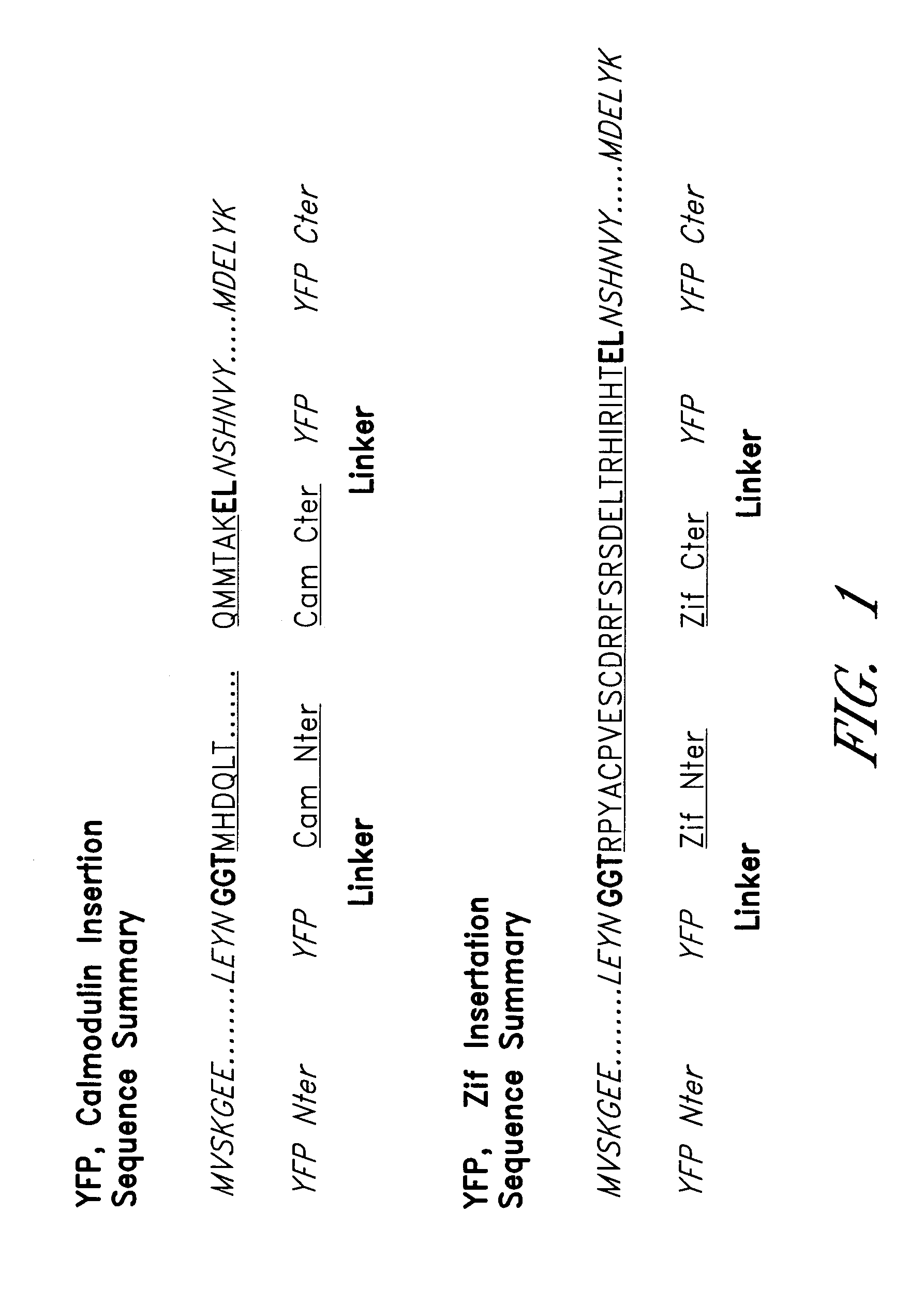Circularly permuted fluorescent protein indicators
a fluorescent protein and permutation technology, applied in the field of fluorescence proteins, can solve the problems the use of gfps as a biosensor is limited, and the relative low molecular weight indicator can suffer from many technical problems, and it is not possible to make a single gfp molecule fluorescence-sensitive to a substrate other than hydrogen ions
- Summary
- Abstract
- Description
- Claims
- Application Information
AI Technical Summary
Benefits of technology
Problems solved by technology
Method used
Image
Examples
example 1
Cells and Protein Purification:
[0139]Bacteria used in this study were BL21(DE3) Gold cells from Stratagene. Transformation was performed by electroporating cells suspended in 10% glycerol directly with a ligation mixture (0.1 cm cuvette, 12.5 kV / cm, 200 Ω, 25 uFd). For protein expression, cells were grown in LB broth containing 100 mg / L Ampicillin to an OD600 of 0.6, at which time they were induced with 1 mM isopropylthiogalactoside. Bacteria were allowed to express recombinant protein for 6 hours at room temperature and then overnight at 4° C. The bacteria were then pelleted by centrifugation, resuspended in 50 mM Tris, 300 mM NaCl and lysed with a French Press. The bacterial lysates were centrifuged at 30,000×g for 30 minutes, and the supernatants were incubated with NiNTA resin (from Qiagen, used for purifying circularly permuted GFP and Calmodulin Insertions) or Cobalt Talon Resin (from Clontech, used for purifying zinc-finger inserts).
Cloning and Gene Construction:
[0140]Yellow ...
example 2
[0159]This example provides a characterization of citrine, which is a YFP mutant (S65G / V68L / Q69M / S72A / T203Y), and dsRed (Heikal et al., Proc. Natl. Acad. Sci., USA 97:11996–12001 (2000), which is incorporated herein by reference).
A. Methods
[0160]Citrine was created with the QuickChange™ Site-Directed Mutagenesis Kit (Stratagene) by using the cDNA coding for the mutant 10C Q69K (Miyawaki et al., Proc. Natl. Acad. Sci., USA 96:2135–2140 (1999), which is incorporated herein by reference). Both dsRed (CLONTECH) and Citrine DNAs were cloned into the vector pRSETB (Invitrogen). Proteins were produced in JM109 (DE3) Escherichia coli (Baird et al., supra, 2000), purified by nickel chelate chromatography on NiNTA-agarose, dialyzed against 10 mM Tris-HCl, pH 7.5. They were stored at 4° C. before dilution into buffers at various pH for spectroscopy.
[0161]One-photon absorption spectra were measured with a single-beam HP-8451-A Diode Array Spectrometer, whereas the fluorescence spectra were reco...
PUM
| Property | Measurement | Unit |
|---|---|---|
| Fraction | aaaaa | aaaaa |
| Volume | aaaaa | aaaaa |
| Biological properties | aaaaa | aaaaa |
Abstract
Description
Claims
Application Information
 Login to View More
Login to View More - R&D
- Intellectual Property
- Life Sciences
- Materials
- Tech Scout
- Unparalleled Data Quality
- Higher Quality Content
- 60% Fewer Hallucinations
Browse by: Latest US Patents, China's latest patents, Technical Efficacy Thesaurus, Application Domain, Technology Topic, Popular Technical Reports.
© 2025 PatSnap. All rights reserved.Legal|Privacy policy|Modern Slavery Act Transparency Statement|Sitemap|About US| Contact US: help@patsnap.com



